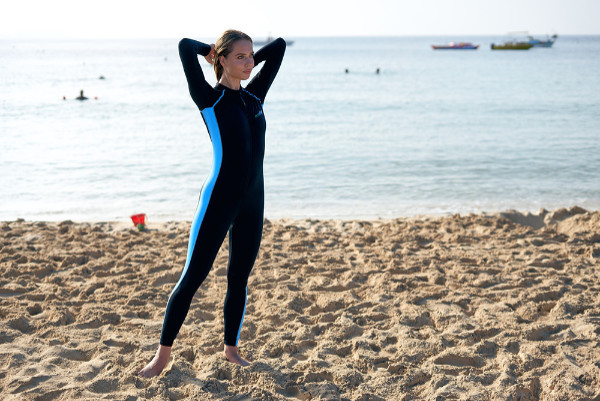What Is The Difference Between Stinger Suit, Dive Skin, Wetsuit, Drysuit and Dive Suit?
Posted by ecostinger on 19th Aug 2014
The Difference Between These Suits Can Be Summarized Into two Categories:
1.
Stinger Suits and Dive Skins: suitable for warm and lukewarm water temperature starting from around 20°C (70°F) to 30°C (86°F) and above;
2.
Wetsuits, Dive Suits and Drysuits: suitable for cool and cold water temperature between around -2 to 25°C or 28 to 77°F depending on thickness and material used.
1. Stinger Suits And Dive Skins:
Both type of swim suits refer to the same category of full body swimsuit traditionally made from swimwear material similar to Lycra, Spandex, Elastane, Nylon and the new generation Polyester/PBT which is also chlorine resistant. These suits are commonly used for above water sports activities such as swimming, surfing, sailing, and under water activities such as snorkeling and shallow diving in water temperature from around 20 °C (70 °F) to 30°C (86°F) and above, and can be used in heated pools or hot weather conditions due to their thin material layer. This type of suits provide little thermal function, and does not seal the skin from getting wet, however they do protect the skin from the sun UVA and UVB radiation, Jellyfish stings, sea lice, abrasion and sunburn which can damage the skin and ultimately cause skin cancer. New generation stinger suits and dive skins are made from high quality chlorine resistant and shape retention fabric composed of Polyester and PBT yarn, they provide Jellyfish protection and UPF50+ UV cover. Some divers wear this type of stinger suit or dive skin under a Wetsuit or Dive suit, in order to allow easier donning, it also provides additional comfort and skin relief for those who experience skin allergy from neoprene or rubber material which most Wetsuits and Dive suits are made of.
2. Wetsuits, Dive Suits And Drysuits:
These type of suits are made from neoprene and/or rubber materials which provide thermal protection and can be used in colder water temperature between -2 and 25°C (28 to 77 °F) depending on thickness of the suit and insulation provided. They can be challenging to use especially where flexibility and comfort are needed.
Some light weight Wetsuits are made from thin neoprene (0.5mm) which can provide some freedom of movement to a certain extent, and it does not provide thermal protection or prevent the skin from getting wet. In general a light weight Wetsuit provide basic warmth and skin protection, and is suitable for light diving activities.
Dive Suits and Drysuits provide better insulation and waterproof then a Wetsuit, especially suits made of rubber material, which can also seal the skin from getting wet; they can be heavy and provide less flexibility, used for deep diving due to their ability in keeping the body heat in cold water temperatures. These dive suits are not easy to wear on or off, that's why experienced divers wear a stinger suit or dive skin under a Dive suit or Drysuit.
|
Comparison Table: |
Stinger Suits And Dive Skins |
Wetsuits, Dive Suits And Drysuits |
|
Fabric Composition: |
Lycra, Spandex, Elastane, Polyester |
Neoprene Rubber |
|
Fabric Weight/ Thickness: |
160 to 200 gsm (gram per sq.m) ... |
0.5 to 7mm (millimeters) |
|
Water Temperature: |
20°C (70°F) to 30°C (86°F) and above |
-2 to 25°C or 28 to 77°F |
|
Activities: |
Swimming, Snorkeling, Shallow Diving |
Deep Underwater Diving |
|
UV Protection: |
UPF50+ blocks >97.5% of the UV Rays ... |
UPF50+ blocks >97.5% of the UV Rays |
|
Sea Animal Protection: |
Jellyfish, Sea Lice Sandflies |
Jellyfish, Sea Lice Sandflies |
|
Comfort: |
Very Comfortable |
Can be Restrictive |
|
Ease of Wear: |
Easy to put on and off can be worn under a Dive/Dry Suit |
Can be challenging to wear and take off |
When would you use a Stinger Suit or Dive Skin?
Full Body Swimsuit, Stinger suit and Dive skin have a thin and light weight fabric, perfect for use in snorkeling, shallow diving, surfing, underwater swimming, jet skiing, sailing, surfing, paragliding, scuba diving, competition and casual swimming in open waters or chlorinated pools due to its chlorine resistant ability; Fabric is similar to traditional swimwear material in touch and feel yet much more superior and durable, provide UPF50+ sun protection blocking >97.5% of the sun UVA and UVB radiation, protect against Box Jellyfish stingers and Sea Lice, and fits like second skin for maximum comfort and functionality. Some include built-in hood, lining, or flat-lock stitching which enhances the suit protection and compression ability. These suits can be used for all type of water sports activities, however If extra warmth or deep water diving is required than we recommend a neoprene or rubber Wetsuit which can help preserve the body heat while swimming in cold waters.
What are the types of Wetsuits and Drysuits?
In general a Wetsuit is made of Neoprene and/or thin rubber material, it is generally used in cool weather condition to provide some warmth. this type of suit does not prevent the skin from getting wet, the thickness of these suits starts from 0.5mm and can go up to 7mm.
A Drysuit can be made of compressed Neoprene which makes it waterproof or may include several layers laminated together which helps keep the skin dry when underwater, these type of suits can be used in cold water conditions and deep diving depending on the thickness and layers used. In general a compressed neoprene suit provide more warmth than layers laminated suit, however they are also more heavier. It is also possible to wear a stinger suit or dive skin under these type of suits for added warmth.

